Before Frankenstein even starts, the movie wants you to know that it isn’t messing around. This isn’t a horror-comedy, or a mildly spooky drama. This is a horror story, make no mistake.
The film opens up in a rather unconventional way. Edward Van Sloan, who plays Dr. Waldman in the film, appears from behind a curtain in order to directly address the audience:
“How do you do? Mr. Carl Laemmle feels it would be a little unkind to present this picture without just a word of friendly warning. We’re about to unfold the story of Frankenstein, a man of science who sought to create a man after his own image without reckoning upon God. It is one of the strangest tales ever told. It deals with the two great mysteries of creation: life and death. I think it will thrill you. It may shock you. It might even horrify you. So if any of you feel that you do not care to subject your nerves to such a strain, now is your chance to, uh… Well, we’ve warned you.”
After this genial warning, Mr. Van Sloan steps back behind the curtain, and the music starts over the credits. (This is the only time music will play during the film.)
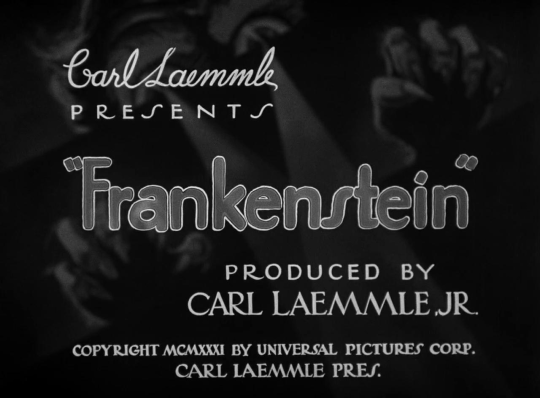
The film opens proper this time, appropriately enough, in a graveyard.
The scene is a funeral, a sad occasion over which church bells are heard ringing. Fittingly enough, the story of Frankenstein already is focused on death, and so is our possible main character.
Enter Dr. Henry Frankenstein. (Colin Clive) (Spoilers below)

Frankenstein waits outside the graveyard, alongside his hunchback assistant, Fritz (Dwight Frye), for the mourners to leave, and for the gravedigger to finish up. As soon as the cemetery is deserted, the gruesome twosome move in, using their own tools to dig up the grave again, removing the coffin. As they do, Frankenstein manically murmurs this:
“He’s just resting. Waiting for a new life to come.”
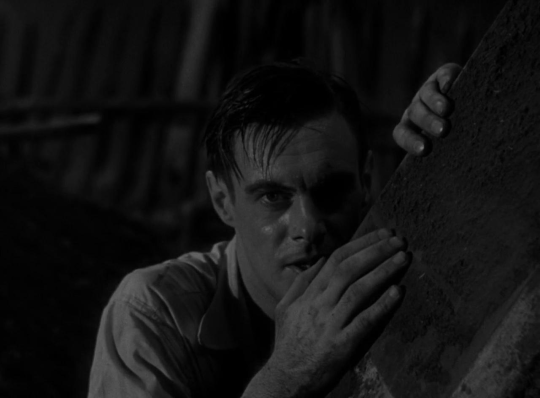
With that, the pair put the coffin on a wheelbarrow, and head off. They stop at a gallows, where Frankenstein tells Fritz to clamber up and cut the body down. Reluctantly, Fritz obeys. The doctor examines the body, before proclaiming it useless.
“The neck’s broken. The brain is useless. We must find another brain.”
He’s 2 for 2 on the ominous foreshadowing, despite the fact that that’s not how neuroscience works.
Fritz, in a quest to find another brain, hides outside a medical college, where he listens to Dr. Waldman (Edward Van Sloan) teaching a seminar about brains. He has two specimens: one, a perfect example of a model brain, and the other, the brain of a criminal.
After class is dismissed, Fritz sneaks into the classroom, intending to steal the well-adjusted brain. At first, it looks like success, but a loud noise startles him, and he drops it. Panicked, Fritz grabs the brain labeled: ‘Abnormal Brain’ and takes off.
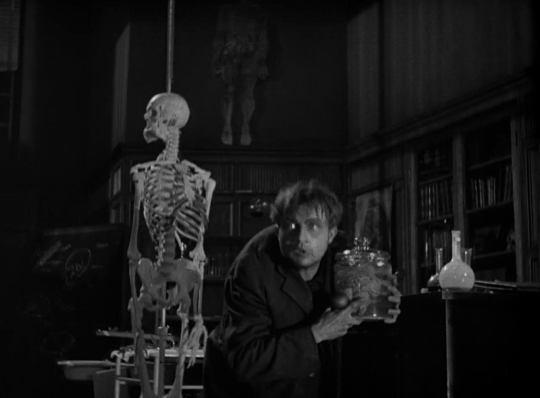
Meanwhile, we are introduced to a few new characters: Elizabeth (Mae Clark), Henry’s fiancee, and Victor (John Boles), friend of Henry and Elizabeth. Elizabeth has just received word from Henry for the first time in four months. She reads the letter out loud to Victor, who explains that he is in the middle of an amazing discovery, and is working on his experiments in hiding in an abandoned watchtower, where they can remain secret.
Elizabeth explains that she sent for Victor because she is worried about Henry, saying that he’s talking as though he’s crazy. She also says that she’s heard him talk about these experiments before, and that when they were first engaged, Henry was happy to tell her about them, but now acts as though everything is a great mystery.
Victor agrees that Henry’s acting strangely. He tells Elizabeth that the last time he ran into Henry and asked to see the lab, Henry got very defensive.
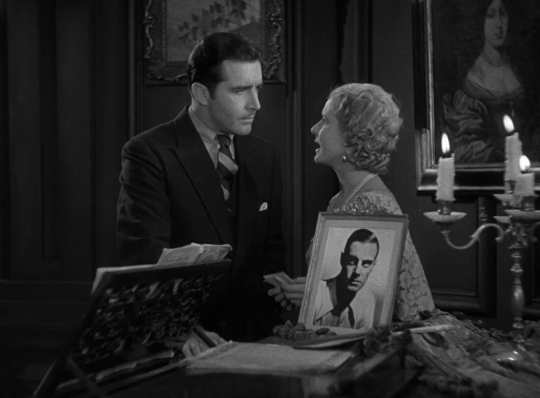
So far, the movie really isn’t selling the audience on Henry. Not many good traits for this guy if we’re being honest.
At this moment, Victor tells Elizabeth that he is in love with her, which doesn’t help the situation at all. This is not the first time he has done this, but Elizabeth is already engaged to aforementioned mad-scientist.
Victor also says that he will go track down Dr. Waldman (remember him?) who was Henry’s mentor, to see if he knows anything about Henry’s behavior. Elizabeth runs after him, determined to go along, and the two set off.
The two arrive at Waldman’s office and begin discussing Henry and his odd behavior. Waldman admits that Henry is brilliant, but he’s also erratic, possessing an “insane ambition to create life”. Waldman also explains that Henry had wanted actual human corpses for his experiments
“You do not quite get what I mean. Herr Frankenstein was interested only in human life. First, to destroy it; then, recreate it. There you have his – mad dream.”
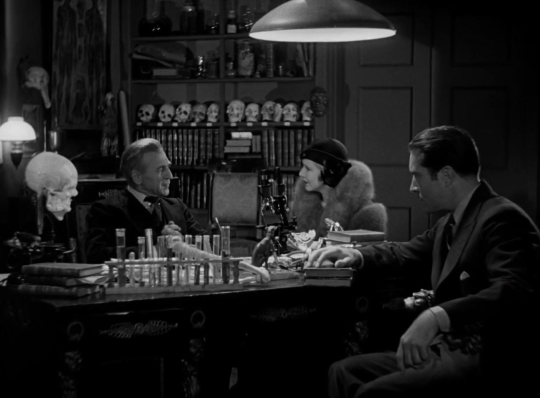
The university obviously wouldn’t allow the use of human corpses, and so Henry left, in order to pursue graverobbing for his experiments. More worried than ever, Elizabeth convinces Waldman to accompany them to find Henry and bring him to his senses.
Henry, as it turns out, is inside his watchtower where a mighty storm is brewing. It’s dark, there’s a thunder and lightning storm growing, and inside, Henry is busy about his laboratory, full of crackling electric gadgets and a table, on which lies a figure, with a cloth lying over it and bandages wrapped around its head, inside which is the brain that Fritz had stolen.
“The brain you stole, Fritz. Think of it. The brain of a dead man waiting to live again in a body I made with my own hands! With my own hands.”
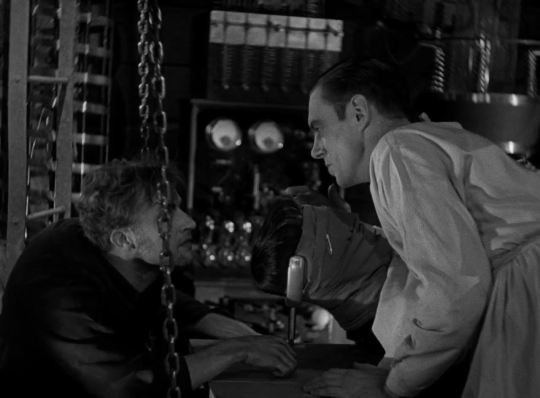
As Henry prepares his experiment (powered by electricity, hence the storm), there is a knock at the door, interrupting him at his work. Irritated, he sends Fritz down to send whoever is there away. Upon realizing that Elizabeth is at the door, Henry changes his mind, and lets her, Victor, and Waldman in, albeit reluctantly. He tries to persuade them to leave, but is stopped short when Victor accuses him of being crazy.
“Crazy, am I? We’ll see whether I’m crazy or not.”
Taking the accusation as a challenge, Henry brings his unexpected guests upstairs to the lab to witness his experiment. He forces Victor and Elizabeth to sit, chases Waldman away from the hidden body, and describes his experiment.
In short, Henry has discovered a ray that is the foundation of life, and that he has created a body, stitched together from other corpses, super large, super strong.
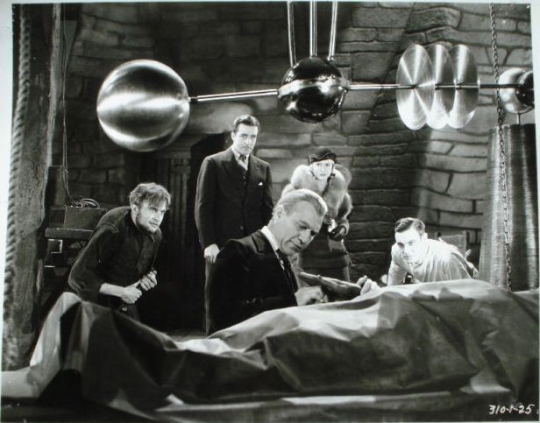
Without further ado, Henry launches into the most famous scene of cinema history. He starts up the equipment as the storm begins to rage, and the table holding Henry’s creation rises up the tower towards a skylight, where the thunder and lightning crash and flash. Slowly, Henry brings the body back down, and the hand of his creation begins to move.
Say it with me:
“Look! It’s moving. It’s alive. It’s alive… It’s alive, it’s moving, it’s alive, it’s alive, it’s alive, it’s alive, IT’S ALIVE!”
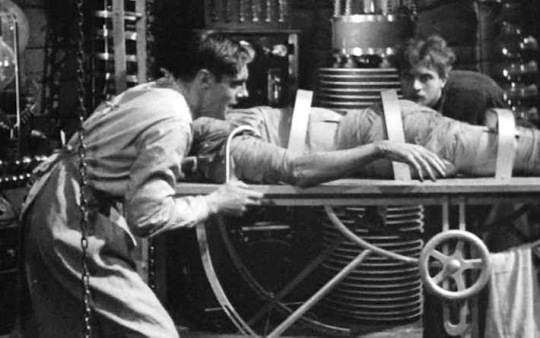
In his euphoria, Henry compares himself to God, and in shock and horror, the others restrain him.
Weirdly enough, at this point, the movie decides to put itself on hold.
After an emotional, tension filled high point, one of the most famous scenes in movie history, the film decides that, rather than show you Frankenstein’s creation, to take you instead to the home of Baron Frankenstein, Henry’s father, and a conversation with Elizabeth and Victor.
The movie has been moving at a pretty good clip up to this point, albeit with rather sparse ‘monster’ action. We don’t see Frankenstein putting his creature together, we only see the before and after, and now we don’t even get to see the after. The sequence interrupting the ‘good stuff’ seems to come in, interrupting a continuous flow.
Henry’s father is also worried about him (it seems to be a pattern), but refuses to believe Elizabeth’s claims that he’s just tired. The Baron believes there’s something legitimately wrong with him, and that he’s involved with another woman. At this point, the Baron isn’t sure if there’s even going to be a wedding between his son and Elizabeth, which is unfortunate, since the whole town is preparing for it.
The Baron makes a decision: he’s going to go visit Henry now, too.
See, as it turns out, Henry hasn’t left the watchtower. He’s still with his experiment, and so is Waldman.
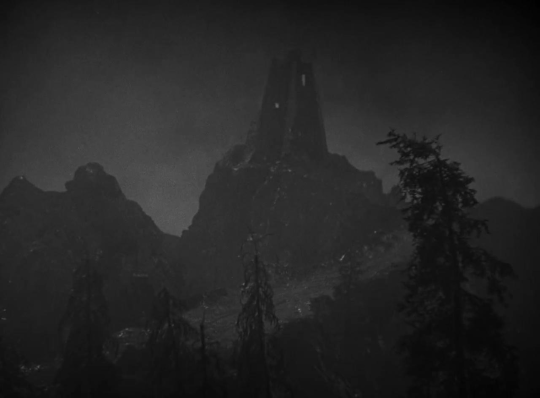
Waldman, for his part, isn’t in the slightest happy about Henry’s experiment. He explains that the ‘monster’ is dangerous, but Henry isn’t buying it.
“Dangerous? Poor old Waldman. Have you never wanted to do anything that was dangerous? Where should we be if no one tried to find out what lies beyond? Have you never wanted to look beyond the clouds and the stars, or to know what causes the trees to bud? And what changes the darkness into light? But if you talk like that, people call you crazy. Well, if I could discover just one of these things, what eternity is, for example, I wouldn’t care if they did think I was crazy.”
Waldman explains that the brain that Henry used was a criminal brain. Henry looks disconcerted for a moment, but brushes it off, ignoring Waldman’s pleas to stop experimenting.
“I’ve got to experiment further. He’s only a few days old, remember. So far he’s been kept in complete darkness. Wait till I bring him into the light.”
As he finishes speaking, heavy footsteps are heard in the hallway. Henry shuts off the light, casting the dark room into further shadow, as a towering figure steps, backwards, through the doorway. It turns, slowly, facing the camera, with a dead, blank expression.

You already know what he looks like.
Henry tells the creature (Boris Karloff) to come in and sit down. The creature, although mute, seems to understand him, obeying as Henry rolls back the skylight.
The monster stands, looking up, and raises his hands to the sky, trying to touch the light. The expression comes to life, full of curiosity-
And Henry closes the light again.

The monster halts, looking dejected, as Henry gleefully brags about his creation.
Right here, we as an audience have been told a lot of information about a lot of people.
There’s Elizabeth, the loving fiancee, Victor, the concerned friend, Waldman, the dismayed mentor, and Baron Frankenstein, blustering father, but when you boil it right down, the audience’s concern lies with two characters: Henry and the monster.
We know that Henry is a raging egomaniac, who is determined to make his mark on scientific discovery. He is proud of what he has done, to the point of hysteria, and has become so absorbed with his work that he has neglected family, friends, and his fiancee, to the point where he has driven them all to worry about him. He’s obsessed with his creation, with his apparent success.

And the creature?
As famous and magnificent as the laboratory scene is, the scene where the monster first sees the light is almost as well-known, and with good reason. Arguably just as important, this sequence gives the audience some very important information about the creature: he is not inherently a ‘monster’. His expression is not that of a vicious beast, but a curious child. His backwards lumber into the room and straining to touch the light stirs an emotion out of the audience: not fear, but pity.
Hold onto that, we’ll be coming back to that shortly.
After the monster sits back down, Fritz comes tearing into the room with a lighted torch, brandishing it at the creature. The creature, naturally frightened, goes into a bit of a frenzy, barely restrained by Henry and Waldman. The two scientists tie him up, and Waldman, more resolute than ever in his stance that the creature is dangerous, tells Frankenstein that he must destroy the monster.
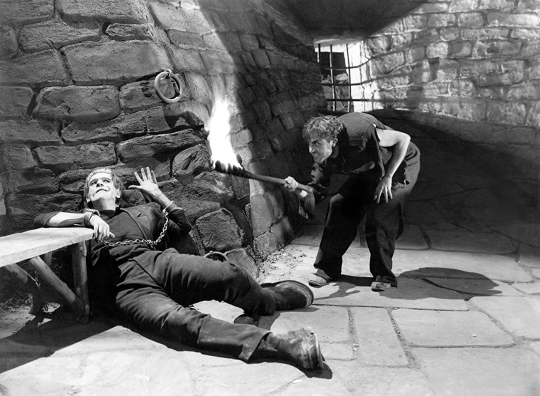
The two scientists move the creature to the cellar, where Fritz continues to torment him, beating him with a whip and antagonizing him with the torch.
Upstairs, Henry and Waldman hear a bloodcurdling shriek, and rush downstairs, where they discover the monster, free, and Fritz, strangled.
The pair manage to get out of the cellar and close the door behind them, but it won’t hold for long. The monster’s superior strength comes to bear as he struggles to smash down the door.
Henry, horrified at his own creation, reluctantly agrees with Waldman’s assertion that the monster must be destroyed, and allows Waldman to go up for a needle for a hypodermic injection. After Waldman returns, the pair open the door, and as the creature attacks Henry, Waldman injects the monster in the back with the needle. After a tense moment, the drug takes effect, and the monster slumps to the ground, unconscious.
Waldman and Frankenstein hide the body of the creature as they hear a banging on the door: Victor, warning Henry that Elizabeth and Henry’s father are on the way, right behind him. Henry goes upstairs to clean the blood off of him.
When Elizabeth and Baron Frankenstein do arrive, they find Henry, collapsed from exhaustion in his lab, muttering mournfully about Fritz. They decide to take him home, and Waldman promises Henry that he will preserve Henry’s research, and destroy the monster.

While Henry is taken home and helped to recover, Waldman sets about dissecting the creature. Before he can get started, the sedative wears off, and the creature wakes up. Seeing the doctor bending over him with sharp tools, the creature strangles Waldman, gets up, and wanders out of the watchtower, now loose across the countryside.
The story takes a little bit of a skip now. Henry is recovered, and it is the day of his wedding to Elizabeth. His father, the Baron, hands Henry and Victor orange blossoms, family tradition for weddings, and toasts the wedding, remarking about his hope for a future son of Frankenstein.
An interesting comment. More on that later.
Meanwhile, the creature’s wanderings have taken him to a forest, relatively close to civilization. There, he stumbles upon a girl named Maria, who is playing by the side of a lake.
Instead of being frightened at his appearance, the girl approaches the creature and invites him to play with her, bringing him down by the water as well. She gives him a flower, which he reacts to with a look of genuine happiness.
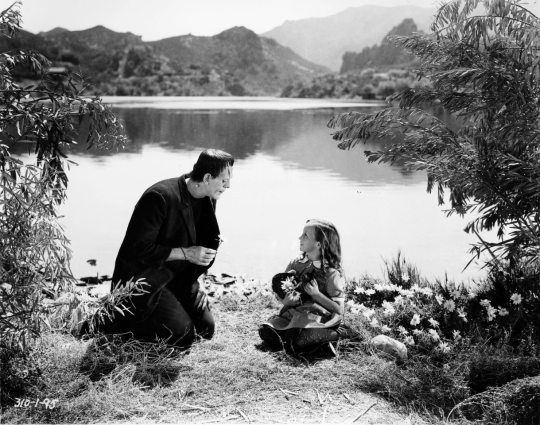
Maria offers up an interesting look at how people approach the creature. Up until this moment, he has been contained, tortured, and treated as an experiment at best, and a monster at worst. This is the first time that anyone has treated him as anything close to ‘human’, and it’s a touching moment.
Unfortunately, this is a horror film, and we have to take a sharp left turn into disaster. Or at least, tragedy.
See, Maria teaches the creature a game where they toss flowers into the water, demonstrating how they float. Once the creature runs out of flowers, he tosses Maria in, not really understanding why that’s not acceptable. As it turns out, Maria can’t swim.
Her floundering in the water frightens the creature, and, clearly upset, he runs away.
The scene switches once more to wedding preparations. Elizabeth, already in her wedding gown, asks to speak to Henry privately, as she’s feeling rather uneasy. As a matter of fact, she’s downright afraid. She explains to Henry that she’s not sure why she’s afraid, but she is concerned for Waldman, and asks why he’s late. She adds that she’s very afraid of losing Henry, but he reassures her that he’s not going anywhere.
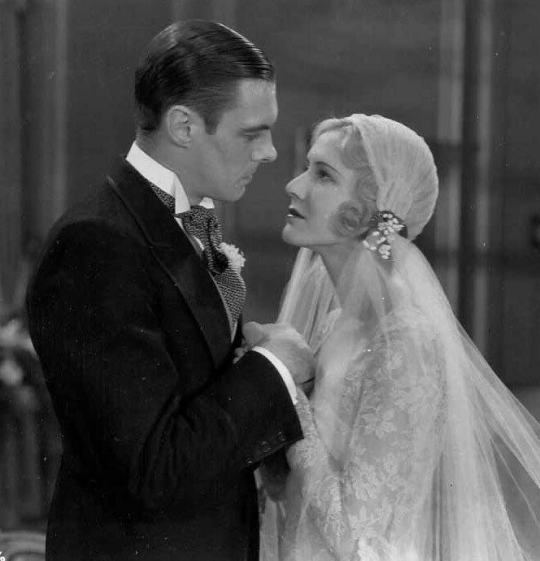
The touching moment is interrupted by Victor, banging on the door, shouting about Waldman. He’s been found, dead, in the watchtower where Henry had been working. Henry locks Elizabeth in a room and rushes out, knowing that the monster must be loose. He and Victor begin searching the house for the creature, all the while thinking that at least Elizabeth is somewhat safe.
Elizabeth is pacing the room, very nervous. I can’t blame her.
As she paces, the monster comes through the window of the house, stalking her down. Elizabeth screams, and tries to escape, but of course, Henry locked the door in his most brilliant move since reanimating the dead. The monster gets out the way he came in, and Henry bursts in to find Elizabeth unhurt, but hysterical.
Henry proclaims that he cannot get married until his creation is destroyed, and leaves Elizabeth in Victor’s care while he leaves to track down the monster.
“I made him with these hands, and with these hands I will destroy him. I must find him.”
Meanwhile, interrupting the wedding festivities outside, a grief-stricken father carries the body of his little girl, Maria, into the town. The townspeople, now subdued, follow him as the father approaches the Burgomaster, proclaiming that his daughter has been murdered. (This is perhaps the one plot hole that I have the hardest time getting around, as if she’d been drowned, there’s no way the father could have figured she’d have been murdered.)
Still, it’s enough to get the townspeople in a riot.
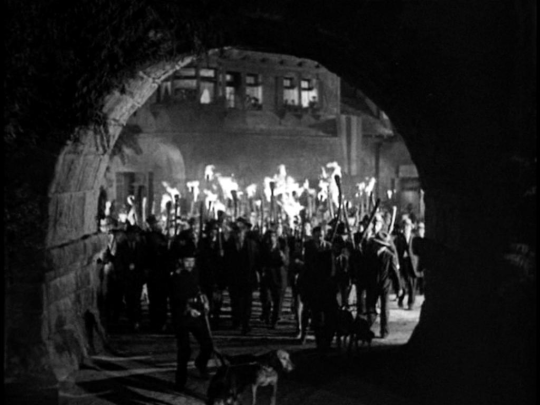
The Burgomaster organizes the mob, splitting it into three groups and putting Henry in charge of one. The mob storms off, armed with torches and pitchforks (what else?).
Henry’s group spots the monster, and stumbles upon an injured man who points them in the direction of the creature.
Naturally, Henry gets separated from the rest of the group while up on a mountain, and, of course, runs into his creation.
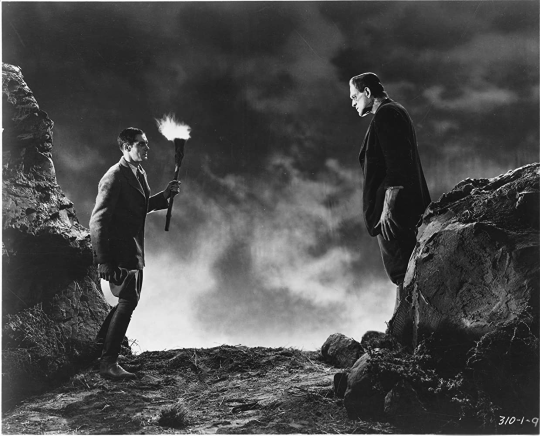
Frankenstein tries to scare the creature with his torch, but the monster is well past the fear of fire by now. He lunges at Henry, they struggle, and the monster knocks him unconscious, dragging him away.
The creature takes Henry into a windmill, pursued by the mob of angry villagers. As the monster lugs Henry up to the second story, the search party tries to break the door down.
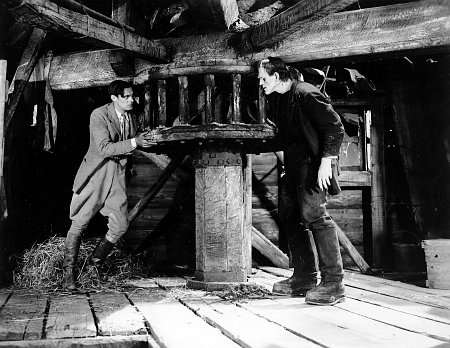
Henry wakes up, and narrowly escapes another attack by the creature, hiding behind mill machinery before entering another losing grappling match with the creature. After a brief struggle, Henry falls from the mill, unconscious.
Some of the search party stop to take Henry home, as the rest light the mill on fire.
The monster remains trapped in the flaming building, under a fallen beam, terrified and alone.

With the monster presumed dead, Henry begins recovering again, under the care of Elizabeth at his home. His father, the Baron Frankenstein, breaks out the old wine for the wedding and makes another toast: a toast to the son of Frankenstein.
Cue closing credits.
The story of Frankenstein is not a long one, clocking in at just over an hour and ten minutes. On a rewatch, it can seem like there isn’t even that much of the monster. Instead, we spend a lot of time with the creator of the creature, watching him prepare for his wedding. We even get a few scenes with Elizabeth and other supporting characters.
At first, these scenes really seem to slow the story down. The odd placement of a few scenes with Henry’s friends and family worrying about his sanity sprinkled in-between the monster’s creation sequences can seem to abruptly grind the movie to a halt as the audience is forced to sit back from the edge of their seats. I mean, what is this story about, anyway? Reanimating the dead or Henry’s wedding?
More specifically, who is this story supposed to be about?
That’s kind of the problem, isn’t it?
The easy answer is to say that Frankenstein as a film is focused on Frankenstein as a man. The scientist, bent on playing God, creating a monster and forced to destroy it. Frankenstein, the son, the fiance, the student, the friend.
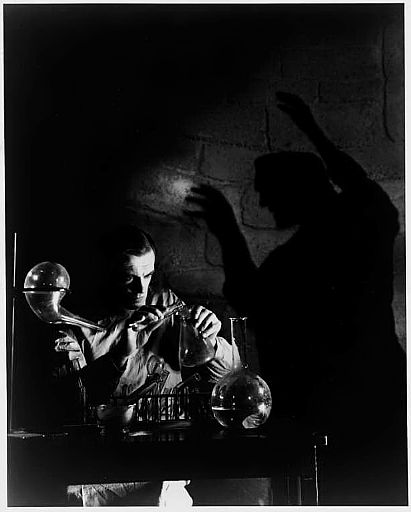
By the same token, it’s equally as simple to claim that the focus of the story is on the monster.
The mute creation of a madman, the childish brute who never asked to be made, who was never shown any kindness. The lonely monster, tortured and brutalized for being ugly, condemned for the sins of his creator. The monster, the son of Frankenstein.
Typically, finding the protagonist of a film isn’t that hard. Luke Skywalker, Rocky Balboa, Dorothy Gale, are all easily presented as who the story is about, the person who pushes the action forward. But unfortunately, protagonists aren’t as easy to spot in every case.
Protagonists, as it turns out, aren’t always at the center of the story. In our study of Ladyhawke (nearly a year ago!), we discovered that sometimes, the protagonist and the character that the audience spends the most time with aren’t necessarily the same person. In Running Scared, there are two protagonists, but only one major one. In our analysis of Psycho, we discussed the fact that the protagonist doesn’t even have to be a hero.
That’s certainly the case with Frankenstein.

Whichever way you slice it, there is no ‘hero’ in Frankenstein. Neither monster nor man saves the day. The climax, presented as a victory to the townspeople, is a tragedy: the creature, beaten and hated for his entire short life, is seemingly burnt alive, trapped, rejected by his creator.
This is not a happy ending. But then again, it’s not a happy story. It started with digging up corpses in a graveyard, remember?
It turns out, when you think back over the events of the film, it’s actually pretty easy to spot the protagonist.
When it comes to ‘spotting’ the protagonist in Frankenstein, it’s less an analysis of the actions taken by specific characters, and more the ‘blame game’. Who’s fault is most of the story? Is it the monster, for killing? Is it Fritz, for antagonizing him unprovoked? Waldman’s, for mentoring Henry in the first place?
Rather grimly, looking back over the course of events in the story and determining who is to blame gives us our protagonist. It is, of course, Henry Frankenstein.
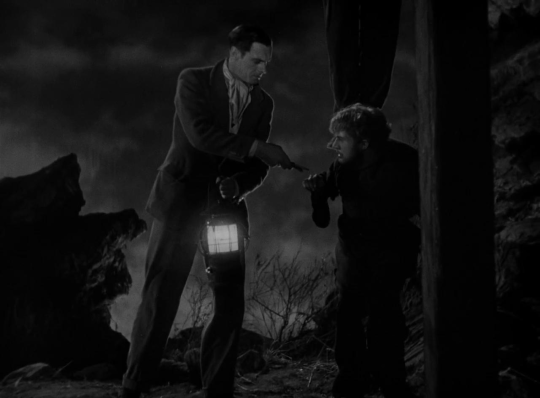
Henry Frankenstein is far from heroic, but he is responsible for nearly every action taken by every character in the story, from his friends checking up on him to his creation wreaking havoc. It is his blind arrogance and refusal to take into account the consequences of his actions that lead to so much suffering, and, ironically, death. Henry is bent on achieving the impossible, and in doing so, nearly dooms much of the main cast. He digs up the graves. He creates the monster.
Worst of all, he’s the one who won’t give the creature what he needs most: love.
For all intents and purposes, the creature is the son of Frankenstein, his creation. Henry has been nothing but an active character up until the point where he creates the monster, and after that, he suddenly becomes passive. His goal accomplished, he doesn’t treat the monster like a person, but a successful experiment. He halfheartedly scolds Fritz for tormenting him, but doesn’t actively try to stop him. Through his carelessness, he gives the monster none of the attention he needs, and as a result, the monster is treated terribly at worst, and with indifference or scientific curiosity at best.
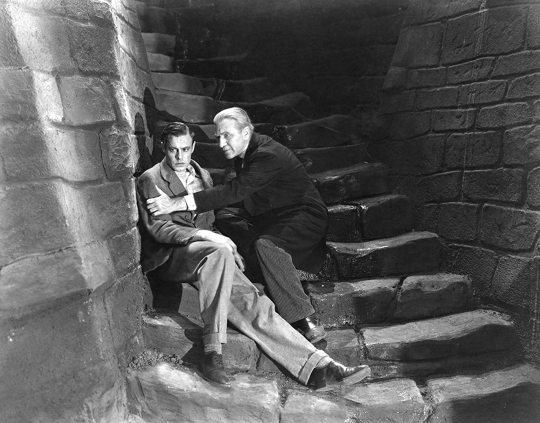
Once people start dying, Henry wakes up a little bit. His growth, his character arc, comes in the form of self-realization, of owning up and accepting blame for what he’s done. After he realizes his guilt, he does something about it, going after the monster and trying to ‘right’ his wrong by destroying it.
While still not exactly a heroic figure, at the very least, Henry does change by the end of the story. And isn’t that what protagonists are supposed to do?
Yes, it is.
But there’s another character we’re leaving out of this equation.
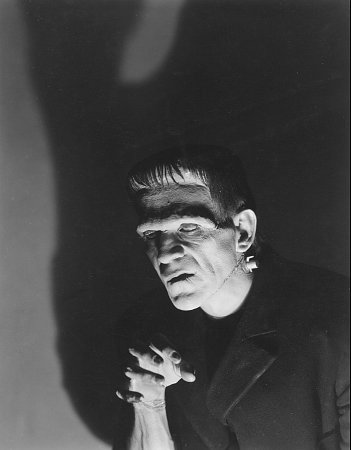
The idea of the monster being a reflection, or another side, of Frankenstein is not a new one. It’s an idea that’s frequently discussed and analyzed by plenty of experts. Right now, though, we’re not looking at the monster as a reflection of Frankenstein. We’re looking at him as a creation, as a son.
See, Henry isn’t the only person that changes throughout the story. While Henry goes from mad monster to man, the creature has a reverse progression.
Throughout the first part of his existence, the creature is a passive character. He is acted upon, created through no will of his own, and then tormented for no good reason. He is a curious creature, a being that demonstrates a childlike joy at the world around him.
The creature doesn’t truly become a ‘monster’ until more than halfway through the film. He kills Fritz, only because he tormented him. He kills Waldman while the doctor is trying to dissect him. In his early moments, the monster reacts to people trying to harm him, rather than lashing out, unprovoked. His interaction with light, and people who aren’t cruel to him, demonstrate the monster’s potential true nature: a gentle giant.

When the monster breaks out of the tower and meets Maria, there is no hostility. He is genuinely happy, enjoying interaction with the first person to show him genuine kindness. Her death is an accident, the result of his misunderstanding, causing him great distress.
After that, a switch is flipped. It is here that he goes after Elizabeth, (though not harming her) and attacks Henry after Henry pursues him. At this point, it can be argued that the creature truly becomes the monster…but it’s hard to say that it’s his fault.
We as an audience don’t know what’s going on in the monster’s head at this point. He can’t speak to tell us. But it’s not a large leap of logic to wonder if the monster might be blaming his misery on Henry and the others in his life as well. And in the end, he is seemingly killed, abandoned by his uncaring creator and shunned by a world who mistreated him without cause.
No matter who Frankenstein is about, it’s a sad story. It’s also a good story.

Frankenstein learns his lesson, repents from playing God, and fixes his mistake. The monster dies. All of the human, ‘non monster’ characters live happily ever after. (Until Bride of Frankenstein.) Good…wins?
There’s no line drawn, no sides of ‘good or evil’ in Frankenstein. The story is not good guy vs. bad guy, no good vs. evil, just a creator and his creation, the tragedy of a man too arrogant to realize the blasphemy of his actions, and the creature he made, turned into a monster due to mistreatment and misunderstanding.
It’s sad, yes. It’s also a satisfying ending.
It ties up loose ends. It answers the questions. It gives everyone an ending, happy or not.

While Frankenstein does have some plot holes, overall, it’s a tight story. More importantly, it’s an emotional story, and a smart story. It brings up questions of morality, of nature vs. nurture, and of what we perceive as monstrous. It’s a gripping story with a great atmosphere, an iconic look, and immortal characters, setpieces, scenes and dialogue that have been remembered for almost ninety years for a reason. It’s an iconic film, a memorable masterpiece of simple, but smart, storytelling, constantly driving at an emotional core that still holds up to this day.
A toast to the son of Frankenstein.
In the articles ahead, we’re going to be taking a look at some of the other important elements to the story of Frankenstein, so if you enjoyed this one, stick around and join us! Don’t forget that my ask box is always open for questions, requests, comments, or just a conversation. Thanks so much for reading, and I hope to see you in the next article.
One thought on “Frankenstein: The Story”